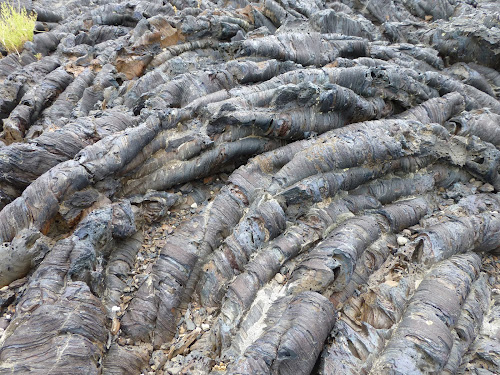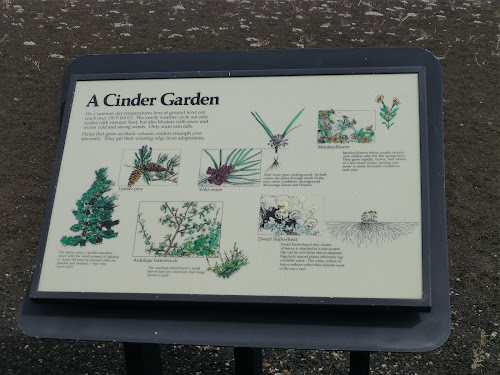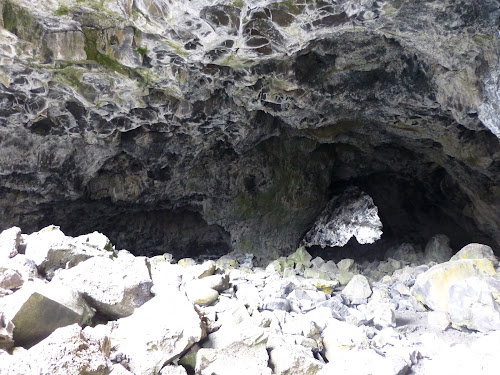We know, based on the title you must be thinking..."Did they really go to the moon to see the craters?!" Well, as it turns out you can actually see the craters of the moon right here on Earth. We included this attraction in our drive between Sun Valley and Jackson Hole since it sits right on Idaho highway 20 and we'll pass right by it...
How about starting with a little geology...remember back in grade school or high school when you learned about the geology of the Earth? We all learned that the Earth has a molten core...and we learned that the Earth's crust (the thin outermost layer) is made up of plates that are moving, right? Well, imagine that there is a spot on the Earth where there is molten material very close to the crust, and as the crust moves across this "hot spot" it wreaks havoc on the crust in the form of different types of volcanic events, and then the plate moves carrying with it the scars of passing over the "hot spot". (Today, Yellowstone National Park lies over the "hot spot" ...that accounts for Old Faithful and the other geysers, as well as the mud pots and hot springs.)
Craters of the Moon is one of those places where the "hot spot" caused volcanic activity through the crust...in addition, this area lies on the Great Rift, a 52 mile long fissure in the crust. So, when the "hot spot" passed under the fissure, it allowed a whole lot of lava to come up to the surface. This all happened about 15 thousand years ago, not too long in geological terms...here's a bird's eye view of the lava fields...
This area was designated a National Monument in 1924, and named Craters of the Moon based on the description of the geologist who led the effort to preserve this landscape. Since then, the monument area has been enlarged several times to encompass more than 1,100 square miles.
When you visit the Craters of the Moon National Monument, you enter this black and desolate landscape and follow a loop road that takes you past the most impressive of the monument's natural features...and along the way you learn a few things about lava!
We began our visit by walking the North Crater Flow Trail which leads us through a lava field which is an old lava flow. We get an up close look at the lava which stretches out in a vast sheet all around us. Here and there piles or columns of lava jut out of the flow...remnants of vents or small spatter cones.
We also see portions of the lava flow that still show how the lava flowed across the landscape...
One of the things we learn about are long ridges that we see in the lava flow, and they are called Squeeze Ups...the name doesn't sound at all scientific to us...and the diagram looks like an ad for a pimple cure product...But the ridge in the lava seen in the next photo confirms the phenomenon, regardless of what we call it...
Here you can see the path with the educational posters along the way...
When a volcano erupts and spits out a lot of gas with the lava, it creates a cinder cone comprised of tiny pellets of lava that accumulate around the vent in a cone shape...
...a young cone...
...and an older cone...
Next, we learn about different kinds of lava...there's the fluid lava that flows like a river, and they call that pahoehoe...then there's the kind that is thicker and moves forward like a crumbling wall, and they call that a-a lava...both Hawaiian words...they too know a little something about lava...
Here's Patty in front of some crater fragments...hard pieces left after a volcano vent erupts then collapses. Some of these are quite tall...
Even though this landscape is so harsh and forbidding, there are plants that live here. The area only gets about 15 inches of rain each year, so these plants are few and hardy...
Here are some more examples of lava that flowed across the surface and then cooled showing the patterns of the flow...
Another phenomenon is called the Spatter Cone, which is a small vent that erupted, ejected globs of lava, then cooled and left this tube shaped lava rock formation...
Here's a picture of the back side of the large older cone, and on the basalt slope there are countless little white flowers struggling to live in the hot black sand-like soil. A well-placed sign helps us to learn a little more about the flowers and plants that struggle so mightily to survive here...
This massive black cone is called the Inferno Cone. It is a huge cone-shaped pile of black basaltic cinder standing above the rest of the monument. It is possible to climb this cone, so we get our hiking shoes on and make the steep half-mile ascent to the summit...
At the top there are a few bushes eeking out an existence, and some great views. To one side we overlook the much larger spatter cones...
This is a view to the southeast along the Great Rift...you can see all of the large mounds in the distance which are the result of eruptions along the rift line (these include the Three Buttes we passed later on our drive through the Idaho National Laboratories area).
And to the northwest we see the "younger cone and the older cone" we saw earlier...
The next stop on our tour of the Craters of the Moon National Monument is the cave area which features a number of partially- or fully-intact lava tubes. A lava tube forms when a lava flow cools on the top and the lava continues to flow beneath the surface. When the lava stops flowing, a hollow lava tube is left behind.
To get to the lava tubes, we have to walk across about a half mile of lava field that is out in the blazing midday sun...it's a little hot out there...And visitors are advised to take flashlights with them so we have our headlamps with us.
As we reach the lava tube area, we get additional information from the signs along the path...this place is very good with their signs and educational information...
Here's our first peak at a lava tube...the opening is a little higher than the path, but we start to get the idea about these tubes...
After a half mile walk, we reach a junction in the path where we can take different routes depending on the tube we want to see...we decide to go to Indian Tunnel which is the largest.
Right here at the junction is the Dewdrops Cave which is a portion of a tunnel that has collapsed..so we can peer right in...We see the lava formations that show lava was flowing here...and Patty stands by the opening so that we can remember how large this tunnel used to be...
Again, the folks here at Craters of the Moon are right on top of it with their educational information...(Spoil Alert: skip to the next paragraph if you don't want to know how the story of every lava tube ends...!) It seems that eventually all lava tubes will collapse, and we see an example of the demise of lava tubes right here next to the path...
We reach Indian Tunnel and we read through the educational info before we descend the steps into the tunnel itself. This tunnel is named for the Shoshone Indians who used the tunnel for shelter and a source of water. The tunnel is 800 feet in length and is about 60 feet below the surface. After we read the information we head down into the tunnel...
Along the length of the tunnel there are several holes in the ceiling which allow light to illuminate large portions of the tunnel...we really don't need our headlamps here...
The tunnel is quite large, at this point it is probably more than 30 feet tall and probably twice that wide. There are piles of lava rubble on the floor of the tunnel that have fallen from the ceiling when sections collapsed.
..."See you later, Patty...!"
The roof of the tunnel has a pattern that has been worn over thousands of years by water that enters the holes in the roof...
After touring the Indian Tunnel, we make the hot walk back across the lava field to the parking lot and our RV. We pull under a rare spot of shade spot and have lunch before resuming our road trip to Jackson, Wyoming.
If you're ever in the neighborhood (or within an hour or two) we'd recommend a visit to the Craters of the Moon National Monument. We had never seen such extensive lava flows before, and the educational information within the monument along the loop drive and pathways is really great.
You can see craters of the moon without ever buying your way onto a Russian spacecraft!




















































No comments:
Post a Comment